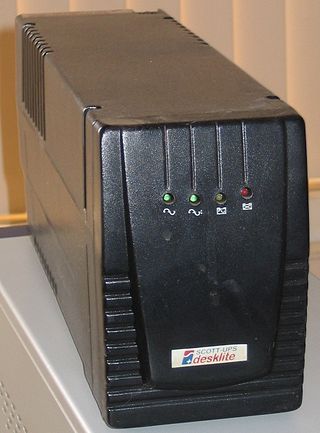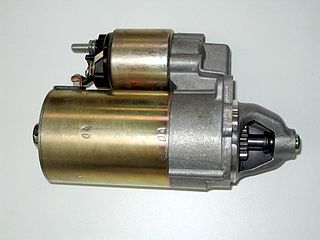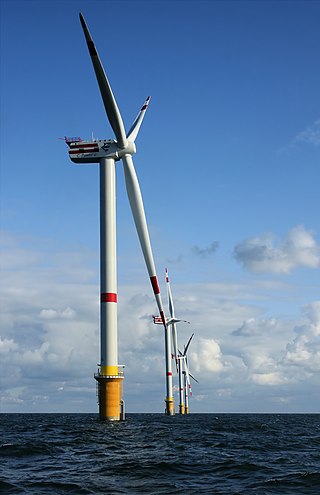Related Research Articles

Electricity generation is the process of generating electric power from sources of primary energy. For utilities in the electric power industry, it is the stage prior to its delivery to end users or its storage.

Auxiliary power is electric power that is provided by an alternate source and that serves as backup for the primary power source at the station main bus or prescribed sub-bus.

An uninterruptible power supply (UPS) or uninterruptible power source is a type of continual power system that provides automated backup electric power to a load when the input power source or mains power fails. A UPS differs from a traditional auxiliary/emergency power system or standby generator in that it will provide near-instantaneous protection from input power interruptions by switching to energy stored in battery packs, supercapacitors or flywheels. The on-battery run-times of most UPSs are relatively short but sufficient to "buy time" for initiating a standby power source or properly shutting down the protected equipment. Almost all UPSs also contain integrated surge protection to shield the output appliances from voltage spikes.

In electricity generation, a generator is a device that converts motion-based power or fuel-based power into electric power for use in an external circuit. Sources of mechanical energy include steam turbines, gas turbines, water turbines, internal combustion engines, wind turbines and even hand cranks. The first electromagnetic generator, the Faraday disk, was invented in 1831 by British scientist Michael Faraday. Generators provide nearly all the power for electrical grids.

A starter is a device used to rotate (crank) an internal-combustion engine so as to initiate the engine's operation under its own power. Starters can be electric, pneumatic, or hydraulic. The starter can also be another internal-combustion engine in the case, for instance, of very large engines, or diesel engines in agricultural or excavation applications.

A power station, also referred to as a power plant and sometimes generating station or generating plant, is an industrial facility for the generation of electric power. Power stations are generally connected to an electrical grid.
Distributed generation, also distributed energy, on-site generation (OSG), or district/decentralized energy, is electrical generation and storage performed by a variety of small, grid-connected or distribution system-connected devices referred to as distributed energy resources (DER).

Cogeneration or combined heat and power (CHP) is the use of a heat engine or power station to generate electricity and useful heat at the same time.

A fossil fuel power station is a thermal power station which burns a fossil fuel, such as coal or natural gas, to produce electricity. Fossil fuel power stations have machinery to convert the heat energy of combustion into mechanical energy, which then operates an electrical generator. The prime mover may be a steam turbine, a gas turbine or, in small plants, a reciprocating gas engine. All plants use the energy extracted from the expansion of a hot gas, either steam or combustion gases. Although different energy conversion methods exist, all thermal power station conversion methods have their efficiency limited by the Carnot efficiency and therefore produce waste heat.

Grid energy storage is a collection of methods used for energy storage on a large scale within an electrical power grid. Electrical energy is stored during times when electricity is plentiful and inexpensive or when demand is low, and later returned to the grid when demand is high, and electricity prices tend to be higher.

Peaking power plants, also known as peaker plants, and occasionally just "peakers", are power plants that generally run only when there is a high demand, known as peak demand, for electricity. Because they supply power only occasionally, the power supplied commands a much higher price per kilowatt hour than base load power. Peak load power plants are dispatched in combination with base load power plants, which supply a dependable and consistent amount of electricity, to meet the minimum demand.

A thermal power station is a type of power station in which heat energy is converted to electrical energy. In a steam-generating cycle heat is used to boil water in a large pressure vessel to produce high-pressure steam, which drives a steam turbine connected to an electrical generator. The low-pressure exhaust from the turbine enters a steam condenser where it is cooled to produce hot condensate which is recycled to the heating process to generate more high pressure steam. This is known as a Rankine cycle.

An emergency power system is an independent source of electrical power that supports important electrical systems on loss of normal power supply. A standby power system may include a standby generator, batteries and other apparatus. Emergency power systems are installed to protect life and property from the consequences of loss of primary electric power supply. It is a type of continual power system.

Off-the-grid or off-grid is a characteristic of buildings and a lifestyle designed in an independent manner without reliance on one or more public utilities. The term "off-the-grid" traditionally refers to not being connected to the electrical grid, but can also include other utilities like water, gas, and sewer systems, and can scale from residential homes to small communities. Off-the-grid living allows for buildings and people to be self-sufficient, which is advantageous in isolated locations where normal utilities cannot reach and is attractive to those who want to reduce environmental impact and cost of living. Generally, an off-grid building must be able to supply energy and potable water for itself, as well as manage food, waste and wastewater.

Hybrid power are combinations between different technologies to produce power.

Wind power has been used as long as humans have put sails into the wind. King Hammurabi's Codex already mentioned windmills for generating mechanical energy. Wind-powered machines used to grind grain and pump water — the windmill and wind pump — were developed in what is now Iran, Afghanistan, and Pakistan by the 9th century. Wind power was widely available and not confined to the banks of fast-flowing streams, or later, requiring sources of fuel. Wind-powered pumps drained the polders of the Netherlands, and in arid regions such as the American midwest or the Australian outback, wind pumps provided water for livestock and steam engines.
Most forms of uninterruptible power supply (UPS) can be either powered by battery or flywheel energy. These are ready for immediate use at the instant that the mains electricity fails, but the relatively small and finite amount of stored energy they contain makes them suitable for short periods of use, typically in the order of a few dozen minutes to a couple of hours depending on the actual load. To get uninterruptible and continuous power supply, a diesel-generator back-up system is needed along with a fuel supply plan that includes on-demand replacement.

A wind turbine is a device that converts the kinetic energy of wind into electrical energy. As of 2020, hundreds of thousands of large turbines, in installations known as wind farms, were generating over 650 gigawatts of power, with 60 GW added each year. Wind turbines are an increasingly important source of intermittent renewable energy, and are used in many countries to lower energy costs and reduce reliance on fossil fuels. One study claimed that, as of 2009, wind had the "lowest relative greenhouse gas emissions, the least water consumption demands and the most favorable social impacts" compared to photovoltaic, hydro, geothermal, coal and gas energy sources.

Power Plant Engineering or Power Plant Engineering abbreviated as TPTL is a branch of the field of Energy engineering, and is defined as the engineering and technology required for the production of an electric power station. Technique is focused on power generation for industry and community, not just for household electricity production. This field is a discipline field using the theoretical basis of mechanical engineering and electrical. The engineering aspects of power generation have developed with technology and are becoming more and more complicated. The introduction of nuclear technology and other existing technology advances have made it possible for power to be created in more ways and on a larger scale than was previously possible. Assignment of different types of engineers for the design, construction, and operation of new power plants depending on the type of system being built, such as whether it is power generation fueled fossil, NPP, hydropower plant, and solar power plant.
References
- ↑ A. Ganjehkaviri, M.N. Mohd Jaafar (2015, January) "Optimization and the effect of steam turbine outlet quality on the output power of a combined cycle power plant." "Energy Conversion and Management" 89(1), 231–243
- ↑ Moreno-Munoz, A., Juan José González De La Rosa, Flores-Arias, J., Bellido-Outerino, F., & Gil-De-Castro, A. (2011, April) “Energy efficiency criteria in uninterruptible power supply." Applied Energy 88(4), 1312-1321
- ↑ Pepermans, G. (2011, December) "The value of continuous power supply for Flemish households. Energy Policy". "Energy Policy" 39(12), 7853-7864
- ↑ Díaz-González, Francisco, Andreas Sumper, Oriol Gomis-Bellmunt, and Fernando D. Bianch (October, 2013) "Energy management of flywheel-based energy storage device for wind power smoothing". "Applied Energy" 110, 207-219
- ↑ Energy.gov. (n.d.) “How Do Wind Turbines Work?” “Office of Energy Efficiency & Renewable Energy”
- ↑ Messer, A'ndrea (2014, April) "Tiny power generator runs on spit." "Penn State"
- ↑ He, Zhen, et.Al. (2005, June) "Electricity Generation from Artificial Wastewater Using an Upflow Microbial Fuel Cell"